Mazda CX-5 Service & Repair Manual: Charcoal Canister Inspection
U.S.A. And CANADA
Leakage inspection
1. Perform the following procedures:
-
Do not operate CV solenoid valve.
-
Assemble the hose used for inspection to port A.
-
Cover ports B and C with the caps.
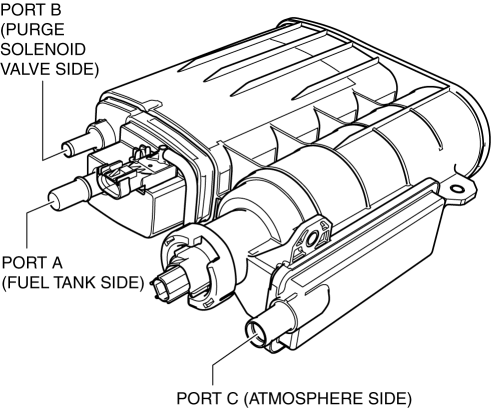
CAUTION:
-
Do not apply a pressure 20 kPa {150 mmHg, 5.91 inHg} or more to the charcoal canister for 1 min. or more. Doing so will damage the charcoal canister.
2. Apply pressure (19.6 kPa {147 mmHg, 5.79 inHg}
) through the hose, and verify that air does not leak from the charcoal canister.
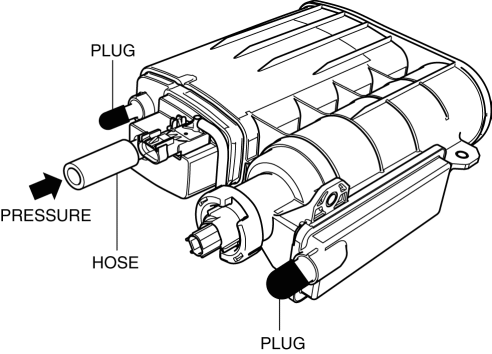
-
If there is airflow, replace the charcoal canister..
-
If there is no airflow, perform the following “Airflow Inspection”..
Airflow inspection
1. Perform the following procedure to verify the charcoal canister airflow.
-
Between port A and port C
-
Plug the port B.
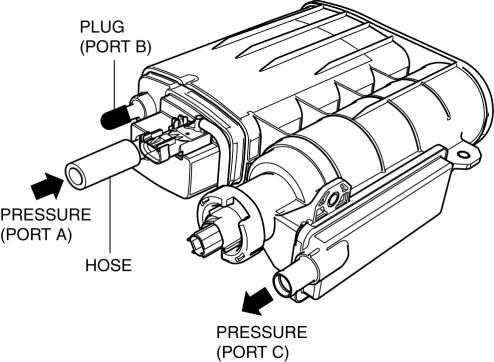
-
Apply a pressure of 1.8 kPa {14 mmHg, 0.53 inHg}
to port A.
-
Verify that there is airflow from port C.
-
If there is no airflow, replace the charcoal canister..
-
Between port B and port C
-
Plug the port A.
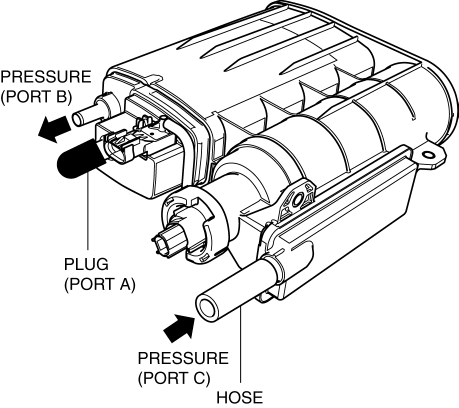
-
Apply a pressure of 2.0 kPa {15 mmHg, 0.59 inHg}
to port C.
-
Verify that there is airflow from port B.
-
If there is no airflow, replace the charcoal canister..
Except U.S.A. And CANADA
Leakage inspection
1. Perform the following procedures:
-
Assemble the hose used for inspection to port A.
-
Cover ports B and C with the caps.
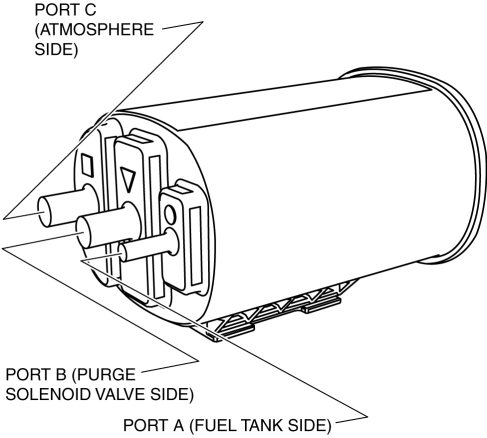
CAUTION:
-
Do not apply a pressure 20 kPa {150 mmHg, 5.91 inHg} or more to the charcoal canister for 1 min. or more. Doing so will damage the charcoal canister.
2. Apply pressure (19.6 kPa {147 mmHg, 5.79 inHg}
) through the hose, and verify that air does not leak from the charcoal canister.

-
If there is airflow, replace the charcoal canister..
-
If there is no airflow, perform the following “Airflow Inspection”..
Airflow inspection
1. Perform the following procedure to verify the charcoal canister airflow.
-
Between port A and port C
-
Plug the port B.
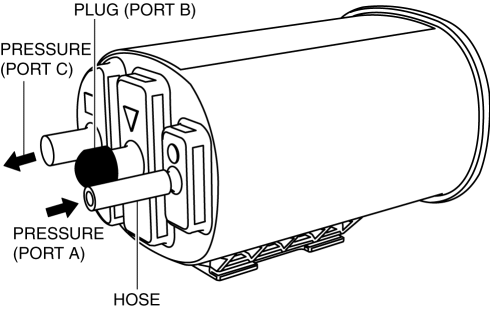
-
Apply a pressure of 0.98 kPa {7.4 mmHg, 0.29 inHg}
to port A.
-
Verify that there is airflow from port C.
-
If there is no airflow, replace the charcoal canister..
-
Between port B and port C
-
Plug the port A.

-
Apply a pressure of 0.98 kPa {7.4 mmHg, 0.29 inHg}
to port C.
-
Verify that there is airflow from port B.
-
If there is no airflow, replace the charcoal canister..
 Catch Tank
Catch Tank
Purpose, Function
Suppresses pulsation occurring before evaporative gas is inducted into the
intake manifold.
Construction
The catch tank is installed in the engine compartment. ...
 Charcoal Canister Removal/Installation
Charcoal Canister Removal/Installation
U.S.A. And CANADA
1. Disconnect the negative battery cable..
2. Remove the floor under cover..
3. Remove in the order indicated in the table.
1
Quick release connect ...
Other materials:
Brake Fluid Pressure Sensor
Purpose/Function
The brake fluid pressure sensor detects the fluid pressure from the master
cylinder and transmits it to the DSC HU/CM.
Construction
The brake fluid pressure sensor is built into the DSC HU/CM. Therefore if
there is any malfunction of the brake fluid pressur ...
Seat Track Position Sensor [Two Step Deployment Control System]
Purpose
The seat track position sensor detects the front and back positions of the
driver seat.
Function
The seat track position sensor converts the seat position into an electrical
signal and sends it to the SAS control module.
Construction
The seat track posi ...
Intake Manifold Vacuum Inspection
1. Disconnect the evaporative hose No.3 (purge solenoid valve side) and install
the vacuum gauge..
2. Verify that the intake air hoses are installed securely.
3. Warm up the engine.
4. Measure the intake manifold vacuum while idling (no load) using the vacuum
gauge.
If not within t ...
